Last Updated on February 5, 2024 by teamobn
Do you have a cat at home that you want to keep from climbing your furniture? A cat castle like any of these is sure to do the trick!
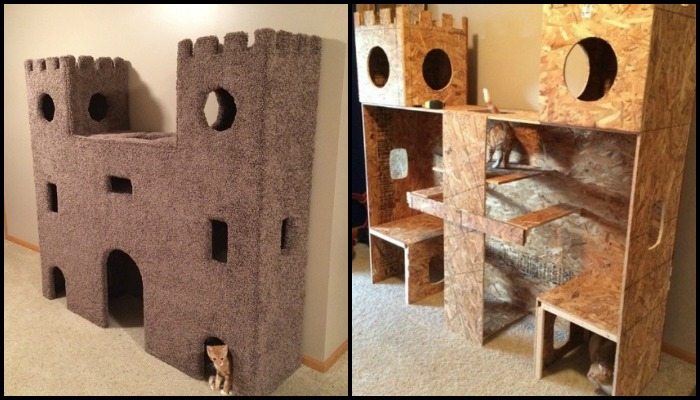
All pets need a place of their own indoors, just like every family member needs their own space. Cats, specifically, love spending time in high places which is why a castle is great to have if you have a pet cat.
One thing we love about cat castles, besides their look, is that The narrower you make its passageways and the thinner the castle is, the more your cats will love it. The higher it is, the better for them, too. Plus, a tall castle looks more awesome!
A cat castle is easy to DIY, especially since you can use a variety of materials to build it. You can use plywood, OSB, or even cardboard boxes!
Take a look at these lovely castles pet owners have DIY-ed for their cats, and be inspired to make one for your beloved feline!
Click on any image to start lightbox display. Use your Esc key to close the lightbox.![]()
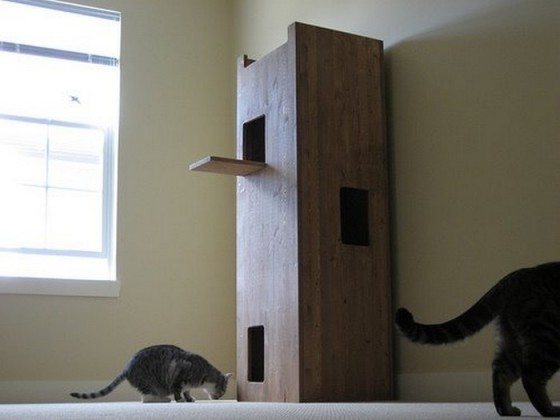

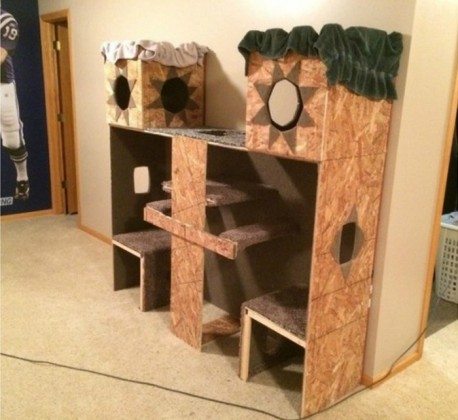
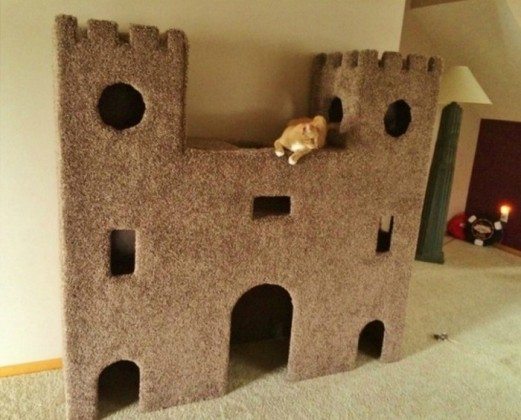
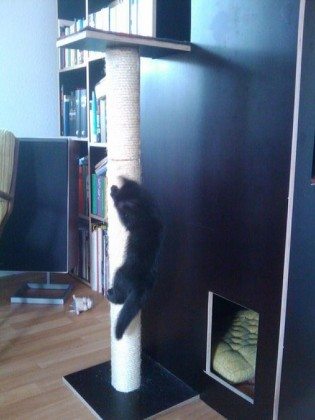
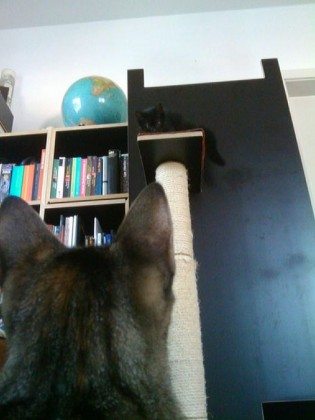
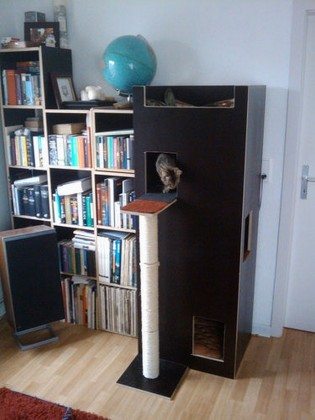
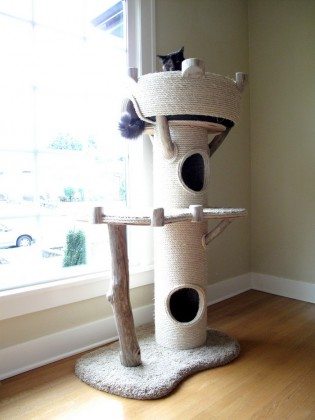
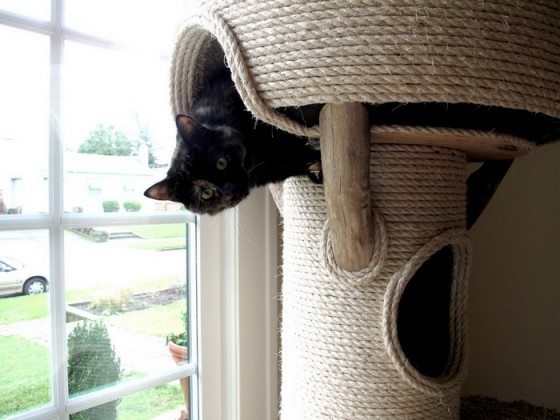
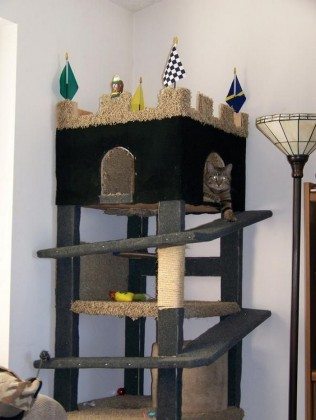
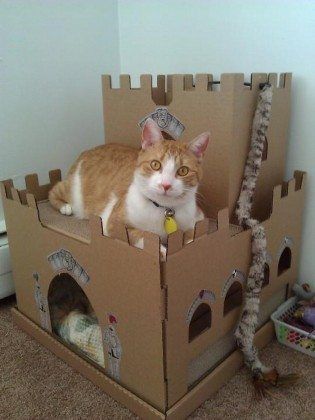
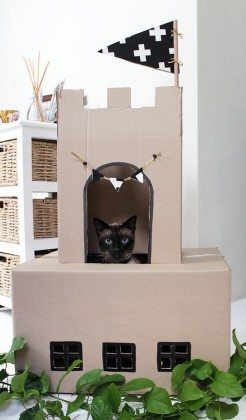
Building a cat castle is a fantastic way to keep your feline friends entertained and stimulated. Here’s a simple guide in 7 easy steps:
Step 1: Gather Materials
Collect cardboard boxes of various sizes, cardboard tubes, non-toxic glue, scissors, tape, old towels or blankets, and any other cat-safe decorations or accessories you want to include.
Step 2: Design Your Castle
Plan out the design of your cat castle. Consider incorporating multiple levels, tunnels, scratching surfaces, and cozy spots for your cats to rest. Keep in mind your cats’ preferences for climbing and hiding when designing the layout.
Step 3: Build the Base
Start by assembling the base of your cat castle using large cardboard boxes. Tape or glue them together securely to create a stable foundation. Ensure that the base is wide enough to provide stability and support for the entire structure.
Step 4: Add Levels and Towers
Use additional cardboard boxes or tubes to create levels and towers for your cat castle. Cut openings in the boxes to create entrances and exits, and secure them in place with tape or glue. Make sure the levels are sturdy enough to support your cats as they climb and explore.
Step 5: Make Hideaways and Platforms
Integrate hideaways and platforms into your cat castle using smaller boxes or sections of cardboard. Cut holes for entrances and exits, and attach them to the structure with tape or glue. Line the hideaways with soft towels or blankets to make them cozy for your cats.
Step 6: Explore and Customize
Get creative with your cat castle! Use non-toxic paint, markers, or decorative paper to add color and patterns to the cardboard surfaces. You can also attach toys, feathers, or hanging strings to create interactive elements for your cats to enjoy.
Step 7: Introduce Your Cats
Once your cat castle is complete, introduce it to your cats and let them explore. Place treats and toys throughout the castle to encourage them to investigate and play. With time, your cats will enjoy their new castle and all the fun it has to offer!
Follow these steps, and you’ll have a fabulous cat castle that will keep your pets busy and entertained for hours on end!
Advantages of Building a Cat Castle
Building a cat castle for your pets offers several advantages:
1. Enrichment and Entertainment: A cat castle provides your feline friends with a stimulating environment to explore, climb, and play. It offers mental and physical stimulation, which is essential for their overall well-being.
2. Prevents Boredom and Behavioral Issues: Cats can become bored easily, leading to destructive behaviours like scratching furniture or excessive meowing. A cat castle gives them a designated space to satisfy their instincts to climb, scratch, and hide, reducing the likelihood of boredom-related issues.
3. Promotes Exercise: Climbing and exploring the different levels of the cat castle encourages physical activity, helping to keep your cats fit and healthy. It’s especially beneficial for indoor cats who may have limited opportunities for exercise.
4. Provides Comfortable Resting Spots: Cat castles often include cozy hideaways and platforms where cats can relax and nap in comfort. These spaces offer a sense of security and privacy, which is important for cats’ mental well-being.
5. Encourages Mental Stimulation: Designing and building a cat castle can be a mentally stimulating activity for pet owners. Additionally, the various levels, tunnels, and interactive elements of the castle provide mental stimulation for cats, keeping their minds engaged and active.
6. Customizable and Cost-Effective: Building a cat castle allows you to customize the design according to your cats’ preferences and space constraints. It’s also a cost-effective alternative to purchasing pre-made cat furniture, as you can use readily available materials like cardboard boxes.
7. Bonding Opportunity: Building a cat castle can be a fun and creative project for you and your family. It provides an opportunity to bond with your pets while engaging in a hands-on activity together.
Overall, building a cat castle offers numerous benefits for both you and your pets, enhancing their quality of life and fostering a deeper bond between you and your furry companions.
Safety Precautions For Your Cat Castle

Building a cat castle sounds like a fun project! But, there are some precautions for you to keep in mind:
- Materials: Ensure that all materials used are safe for cats. Avoid any toxic substances or materials that could splinter or break easily, posing a hazard to your cat.
- Stability: Build the castle to be sturdy and stable to prevent it from toppling over and potentially injuring your cat.
- No small parts: Avoid using small parts or decorations that your cat could swallow and choke on.
- Secure platforms: If your castle will have multiple levels or platforms, make sure they are securely attached and can support the weight of your cat without collapsing.
- Escape routes: Design the castle with multiple entry and exit points so your cat can easily enter and exit without feeling trapped.
- Comfortable surfaces: Use soft, comfortable materials for any bedding or surfaces where your cat will rest.
- Avoid hazards: Be mindful of any dangling cords, sharp edges, or other hazards that could harm your cat.
- Supervision: While building the castle and after it’s finished, supervise your cat’s interactions with it to ensure their safety.
- Location: Place the cat castle in a safe location where it won’t block any escape routes or pose a risk of falling over onto furniture or people.
- Regular inspection: Periodically inspect the cat castle for any signs of wear and tear, and make any necessary repairs to keep it safe for your cat to use.
Designing Cat Castles
Designing cat castles is not just a practical exercise; it’s an opportunity to unleash your creativity and provide your furry friend with a space that reflects their personality and satisfies their instincts. Whether you opt for a modular tower castle, a medieval fortress, a fairy tale castle, a modern minimalist castle, or an outdoor adventure castle, each design offers unique benefits for both you and your cat.
Let’s delve deeper into each design concept, exploring the intricacies of construction, functionality, and the potential impact on your cat’s well-being:
Modular Tower Castle:
- The concept of a modular tower castle offers versatility and adaptability. By creating detachable towers and platforms, you can reconfigure the castle to suit your cat’s evolving preferences and behaviour.
- Materials like cardboard or wood provide a sturdy structure for the castle, while cat-friendly fabrics or carpets ensure comfort and coziness.
- The conclusion drawn from this design is its ability to cater to your cat’s changing needs, ensuring they remain engaged and stimulated by their castle over time.
Medieval Fortress:
- Building a fortress-style castle evokes images of grandeur and adventure. Incorporating elements like turrets, battlements, and a drawbridge adds an element of excitement to your cat’s environment.
- Scratching posts integrated into the design satisfy your cat’s natural urge to scratch, while cozy nooks and hiding spots offer opportunities for exploration and relaxation.
- The conclusion here is that this design not only provides entertainment but also mimics your cat’s instincts to climb and seek refuge, enhancing their overall well-being.
Fairy Tale Castle:
- Inspired by the enchanting world of fairy tales, this design transports your cat to a whimsical realm filled with towers, spires, and decorative elements.
- Soft cushions and plush bedding inside the castle create a cozy retreat where your cat can lounge and dream of magical adventures.
- The conclusion is that this design adds a touch of magic to your home while providing a safe and comfortable haven for your feline companion.
Modern Minimalist Castle:
- A sleek and modern castle design blends seamlessly with contemporary living spaces. Clean lines, geometric shapes, and neutral colours create an aesthetic appeal that complements your home’s décor.
- Hidden compartments and interactive toys incorporated into the castle’s design offer both functionality and stimulation for your cat.
- The conclusion drawn from this design is its ability to harmonize with your lifestyle while providing your cat with a space that meets their needs for play and relaxation.
Outdoor Adventure Castle:
- Taking the castle concept outdoors opens up a world of possibilities. By incorporating natural elements like branches, rocks, and plants, you can create an environment that stimulates your cat’s senses and encourages exploration.
- Ramps, tunnels, and elevated platforms offer opportunities for physical activity and mental stimulation, allowing your cat to enjoy the fresh air and sunshine while engaging in stimulating activities.
- The conclusion here is that an outdoor adventure castle provides a unique opportunity for your cat to connect with nature and lead a more enriched life.
The key to designing the perfect cat castle lies in understanding your cat’s needs, preferences, and natural behaviours. Whether you opt for a modular tower castle, a medieval fortress, a fairy tale castle, a modern minimalist castle, or an outdoor adventure castle, the goal remains the same: to create a safe, comfortable, and stimulating environment where your cat can thrive.
With a bit of creativity, imagination, and craftsmanship, you can design a cat castle that not only enhances your home but also enriches your cat’s life in meaningful ways.
The Wrap Up
Cat castles offer opportunities for cats to engage in physical activities such as climbing, scratching, and jumping. This helps them exercise and maintain a healthy weight, as well as provides the mental stimulation that can prevent boredom and destructive behaviors.
Cats are territorial animals and providing them with their own space, like a cat castle, can fulfill their need for a secure and comfortable area where they can rest and retreat when they feel stressed or overwhelmed.
A well-designed cat castle can provide environmental enrichment, reducing stress levels and promoting overall well-being. Features like hiding spots, elevated perches, and interactive toys can mimic a cat’s natural environment and help them feel safe and content.
Building or purchasing a cat castle can be a fun and creative way for cat owners to bond with their pets. Spending time together assembling or playing in the cat castle can strengthen the relationship between humans and their feline companions.
By providing cats with an appropriate outlet for their natural behaviours, such as scratching and climbing, cat castles can help protect furniture and other household items from damage.
Investing in a cat castle also promotes a harmonious relationship between cats and their owners. By providing a dedicated space for their feline companions, cat owners demonstrate care and consideration for their pets’ well-being. Spending time together assembling or playing in the cat castle can strengthen the bond between humans and cats, fostering a deeper connection based on trust and companionship. Furthermore, cat castles offer a practical solution for protecting furniture and other household items from damage, as they provide cats with appropriate outlets for their natural behaviours, such as scratching and climbing.
The decision to invest time and effort in building a cat castle is not just about providing a fun and engaging environment for cats; it’s about enriching their lives, promoting their health and happiness, and strengthening the bond between cats and their human companions.
It’s a win-win situation that enhances the overall quality of life for both cats and their owners, creating a harmonious and fulfilling living arrangement for all involved.
Frequently Asked Questions
1. What is a cat castle?
A cat castle is a structure designed for cats to climb, play, and relax in. It typically consists of multiple levels, platforms, and hiding spots, often incorporating elements like scratching posts and toys.
In essence, a cat castle is more than just a structure; it is a testament to the bond between humans and their feline companions, a tangible expression of love and devotion. Through its thoughtful design and meticulous craftsmanship, the cat castle serves as a beacon of joy and enrichment, transforming the mundane confines of a home into a vibrant and dynamic realm where cats reign supreme.
2. Why should you build a cat castle for your cat?
Building a cat castle provides your feline friend with a designated space where they can engage in natural behaviours like climbing, scratching, and exploring. It offers mental and physical stimulation, reducing boredom and promoting overall well-being.
3. Do you need special skills or tools to build a cat castle?
Basic DIY skills are helpful, but many cat castle designs can be constructed using simple tools like a utility knife, scissors, and glue. You can find tutorials online or adapt existing designs to suit your skill level.
4. What materials can you use to build a cat castle?
Common materials include cardboard boxes, plywood, carpet remnants, PVC pipes, and sisal rope. You can also repurpose items like old furniture or shelves to create a unique and functional cat castle.
5. Can you customize the cat castle to suit my cat’s preferences?
Yes, building your cat castle allows for customization based on your cat’s size, age, and personality. You can add features like ramps, tunnels, and cozy sleeping areas to tailor the castle to your cat’s needs.
6. Is it safe for your cat to use a homemade cat castle?
As long as you use sturdy materials and secure all components properly, a homemade cat castle can be safe for your cat to use. Avoid any materials with sharp edges or toxic substances that could harm your cat.
7. How do you maintain and clean the cat castle?
Regular maintenance involves inspecting the cat castle for any signs of wear or damage and repairing them as needed. You can clean the surfaces with a damp cloth or vacuum to remove dirt and fur.
8. How big should the cat castle be?
The size of the cat castle depends on the available space in your home and your cat’s preferences. It should be large enough to accommodate multiple levels and provide room for your cat to move around comfortably.
9. Can I add additional features to the cat castle over time?
Yes, you can continue to customize and expand the cat castle as your cat’s needs and preferences change. Adding new elements like toys, scratching posts, or additional levels can keep the castle engaging and exciting for your cat.








